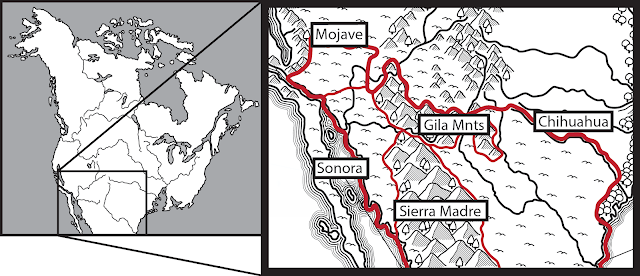Creatures of Taarsh - Part 2
Animals in RPGs
Before designing creatures for use in roleplaying games it is useful to consider the role they will play. In RPGs I run, animals tend to appear in one of four broad roles: animals the characters may trap or hunt in survival situations, domestic animals which characters or NPCs make use of, annoying animals that may appear on Fortune Tables, or dangerous animals which directly threaten the PCs. It is important to note that animals may appear in multiple categories - deer are a classic example of an animal that players may hunt but in large numbers may represent a threat to a party.
Hunting Tables
This is a useful place to list animals which can provide flavour during travel scenes without stopping the flow of the game. Typically hunted animals should be relatively small - most mice, squirrels, or birds are plentiful in forests and too small to threaten even a non-heroic individual. On Taarsh especially large and non-venomous ‘spiders’, ‘centipedes’ or ‘slugs’ may fulfill this role. Additionally, larger animals such as wild goats, deer, or elk may be included here. Especially large and rare herbivores such as rhinos, hippos, or elephants are better reserved for threatening encounters.
It's best to keep animals like this general, as complex descriptions or unique powers will bog down gameplay. Something between 6-12 animals with 1-2 unique creatures per region are more than enough flavour to keep players interested. An example of a 12 animal list for Ontario might be: mice/rats, duck/geese, grouse/turkey, chipmunk/squirrel, rabbit, weasel, beaver, porcupine, skunk, racoon, possum, and deer/elk.
Domestic Tables
This category includes all animals regularly kept by humans (read NPCs) which the party will therefore be around constantly. It also includes animals which may be bought and used by PCs such as mounts. It is important to understand these animals as they will inevitably influence how human cultures function and how PCs are able to interact with the world. One thing of special importance is that not every culture on Taarsh needs an animal to fit every box, or indeed any domestic animals at all. In many ways, having a culture with a noticeably absent animal can be just as interesting.
Below are some common uses of animals and examples of domestic animals on earth.
Meat - poultry, rabbits, sheep/goats, pigs, cattle
Milk - sheep/goats, cattle
Wool - goats/sheep, camels
Baggage - oxen, horses, camels, donkeys, llama/alpaca, elephants, dogs
Mounts - horses, camels, donkeys, elephants, ostriches
Hunting - dogs, hawks
Herding - dogs, llama/alpaca, donkeys
Tracking - dogs, pigs
Forestry - elephants
Fortune Tables
The key defining feature of this group is that encounters with them are not life-threatening. Instead, encounters with them provide or use up resources or add illness or injuries to PCs. This is a great place to put animals which are too small to appear elsewhere but that can still have a big effect - such as venomous spiders or parasites. Examples of annoying animals will be discussed in greater detail in my post on Fortune Tables. Some examples of Ontario animals which might appear on a fortune table include: eastern massassauga (a venomous snake), black widow spider, mosquito, deer tick, and skunk, and porcupine.
Encounter Tables
Animals in this group include only those that could reasonably be able to injure or kill a PC. This means predators, but also large or dangerous herbivores. Each region should have a single apex predator (possibly humanoids) and numerous lesser predators. It may also have numerous or no non-predator threats. In general there should be at least three unique dangerous animals in each region, though there could be more if creativity and time allows. For example, Ontario has at least eight dangerous encounters: coyotes, wolves, wolverines, lynxes, mountain lions, black bears, and moose
Island Evolution & Trends on Taarsh
The most important of these is Gause’s Law - two animals which compete for the same resource cannot coexist long term be conscious when having multiple animals competing for the same resources, as this competition would not be sustainable long term.
Another important idea is Foster’s Rule - a trend in animal evolution whereby large animals tend to shrink in size over generations and small animals tend to grow in size resulting in a net loss of diversity in terms of species size. Examples of ‘gigantic’ island animals include cassowaries, komodo dragons, and the extinct moa of New Zealand (featured above). Examples of ‘dwarf’ island animals include the dwarf elephants of the ancient Mediterranean and Homo floresiensis. Like the latter, humans on Taarsh, especially those who live exposed to the polluted air and water of the planet, are invariably stunted. These ‘outlanders’ typically stand no more than four feet, with three feet being the more common height.
Limb loss or general loss of mobility is another common evolutionary trend where herbivores are separated from active predators. This is most easily observed in birds, who on earth often lost the ability to fly, to disastrous results once new predatory animals - such as cats - were introduced on their island homes. On Taarsh, animals, both birds and insects, may lose their ability to fly when not threatened by predators. Alternatively - animals that are able to swim or climb may lose the ability if it is no longer necessary for their survival. Amphibians, common on pre-colonial Taarsh, may adapt to live entirely on land.
Taarsh is also a hot world, its once earth-like atmosphere growing increasingly humid due to the thickness of the atmosphere. Because of the increased temperature, long limbs and large ears - good ways to increase surface area and thereby reduce heat retention - will be common in all animals.






Comments
Post a Comment